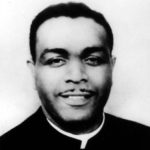
Oliver Brown
“He was a person who believed in the right thing for everybody,” Oliver Brown’s widow, Leola Brown Montgomery, now 93, talking about her husband days before the 60th anniversary of the Supreme Court Brown vs. Board of Ed decision. “Whenever he had a chance, he would take the opportunity to try to encourage the people, and our people especially.”
Oliver Brown, 32 at the time the suit against the school district was brought, served as an assistant pastor at Topeka’s black Methodist church and as a welder for the Atchison, Topeka, and Santa Fe Railway.
Brown and his wife had three children, ages 8, 4, and 5 months at the time of trial. Linda Brown attended all-black Monroe Elementary, a school located 21 blocks from their home on West First Street. Oliver Brown testified that “many times [Linda] had to wait through cold, the rain, and the snow” for a bus to take her to Monroe, even though the family lived only seven blocks from an all-white elementary school. Oliver also testified that Linda’s route to her bus stop took her over a “main thoroughfare…with a vast amount of traffic.”
By the time the Supreme Court announced its decision in Brown, and the Topeka schools desegregated, Linda had moved on to a previously integrated junior high school. Linda’s siblings, however, enjoyed the benefits of a desegregated elementary school education.
Oliver Brown and his family moved to Springfield, Missouri in 1959 where he served as a minister. He died of a heart attack in 1961.
- Brown v. Board of Education, decided in 1954, was a landmark U.S. Supreme Court case in which the Court declared state laws establishing separate public schools for black and white students to be unconstitutional.
- The decision overturned the Plessy v. Ferguson decision of 1896, which allowed state-sponsored segregation, insofar as it applied to public education.
- Handed down on May 17, 1954, the Warren Court’s unanimous (9–0) decision stated that “separate educational facilities are inherently unequal.”
- As a result, de jure racial segregation was ruled a violation of the Equal Protection Clause of the Fourteenth Amendment of the United States Constitution.
- This ruling paved the way for integration and was a major victory of the civil rights movement.
Watch an MSNBC video below:



